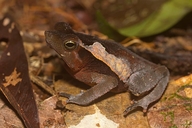|
Rhinella lescurei Fouquet, Gaucher, Blanc & Vélez-Rodriguez, 2007
| family: Bufonidae genus: Rhinella |
| Species Description: Fouquet, A., Gaucher, P., Blanc, M., Velez-Rodriguez, C.M. 2007. Description of two new species of Rhinella (Anura: Bufonidae) from the lowlands of the Guiana shield. Zootaxa 1663: 17-32. | |
 © 2014 Jean-Pierre Vacher (1 of 2) |
|
|
|
Description This species is highly polymorphic. The coloration of the back can be uniformly brown to light gray, or with a variety of leaf-like patterns with successive shades of dark to light brown or gray. A whitish mid-dorsal stripe can occur and can be very thin to 5 mm wide. Flanks are generally darker than the back. Distribution and Habitat Country distribution from AmphibiaWeb's database: French Guiana, Suriname
Life History, Abundance, Activity, and Special Behaviors This species is likely not abundant.
References
Fouquet, A., Gaucher, P., Blanc, M. and Velez-Rodriguez, C. M. (2007). ''Description of two new species of Rhinella (Anura: Bufonidae) from the lowlands of the Guiana shield.'' Zootaxa, 1663, 17-32. Originally submitted by: Antoine Fouquet (first posted 2008-01-14) Edited by: Kellie Whittaker (2008-01-27) Species Account Citation: AmphibiaWeb 2008 Rhinella lescurei <https://amphibiaweb.org/species/7022> University of California, Berkeley, CA, USA. Accessed Nov 21, 2024.
Feedback or comments about this page.
Citation: AmphibiaWeb. 2024. <https://amphibiaweb.org> University of California, Berkeley, CA, USA. Accessed 21 Nov 2024. AmphibiaWeb's policy on data use. |


 Map of Life
Map of Life